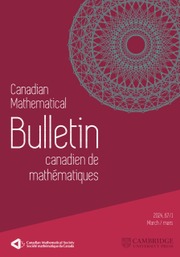No CrossRef data available.
Article contents
Hausdorff Prime Matrices
Published online by Cambridge University Press: 20 November 2018
Abstract
Core share and HTML view are not available for this content. However, as you have access to this content, a full PDF is available via the ‘Save PDF’ action button.
In this paper we give the form of every multiplicative Hausdorff prime matrix, thus answering a long-standing open question.
Keywords
Information
- Type
- Research Article
- Information
- Copyright
- Copyright © Canadian Mathematical Society 2012
References
[1] Agnew, R. P., On Hurwitz-Silverman-Hausdorff methods of summability. Tôhoku Math. J.
49(1942), 1–14.Google Scholar
[2] Boos, J., Classical and modern methods in summablity. Oxford Mathematical Monographs, Oxford Science Publications, Oxford University Press, Oxford, 2000.Google Scholar
[3] Conway, J. B., Functions of one complex variable, Graduate Texts in Mathematics, 11, Springer-Verlag, New York-Berlin, 1978.Google Scholar
[4] Fuchs, W. H. J., A theorem on finite differences with an application to the theory of Hausdorff summability. Proc. Cambridge Phil. Soc.
40(1944), 189–197.Google Scholar
[5] Hausdorff, F., Summationsmethoden und Momentfolgen. I. Math Z.
9(1921), no. 1–2, 74–109. doi:10.1007/BF01378337Google Scholar
[6] Hille, E. and Phillips, R. S., Functional analysis and semi-groups. rev. ed., American Mathematical Society Colloquium Publications, 31, American Mathematical Society, Providence, RI, 1957.Google Scholar
[7] Hille, E. and Tamarkin, J. D., Questions of relative inclusion in the domain of Hausdorff means. Proc. Natl. Acad. Sci. USA
19(1933), no. 5, 573–577.Google Scholar
[8] Hurwitz, W. A. and Silverman, L. L., On the consistency and equivalence of certain definitions of summability. Trans. Amer. Math. Soc.
18(1917), no. 1, 1–20.Google Scholar
[9] Sharma, N. K., Isolated points of the spectra of conservative matrices. Proc. Amer. Math. Soc.
51(1975), 74–78. doi:10.1090/S0002-9939-1975-0372461-3Google Scholar

